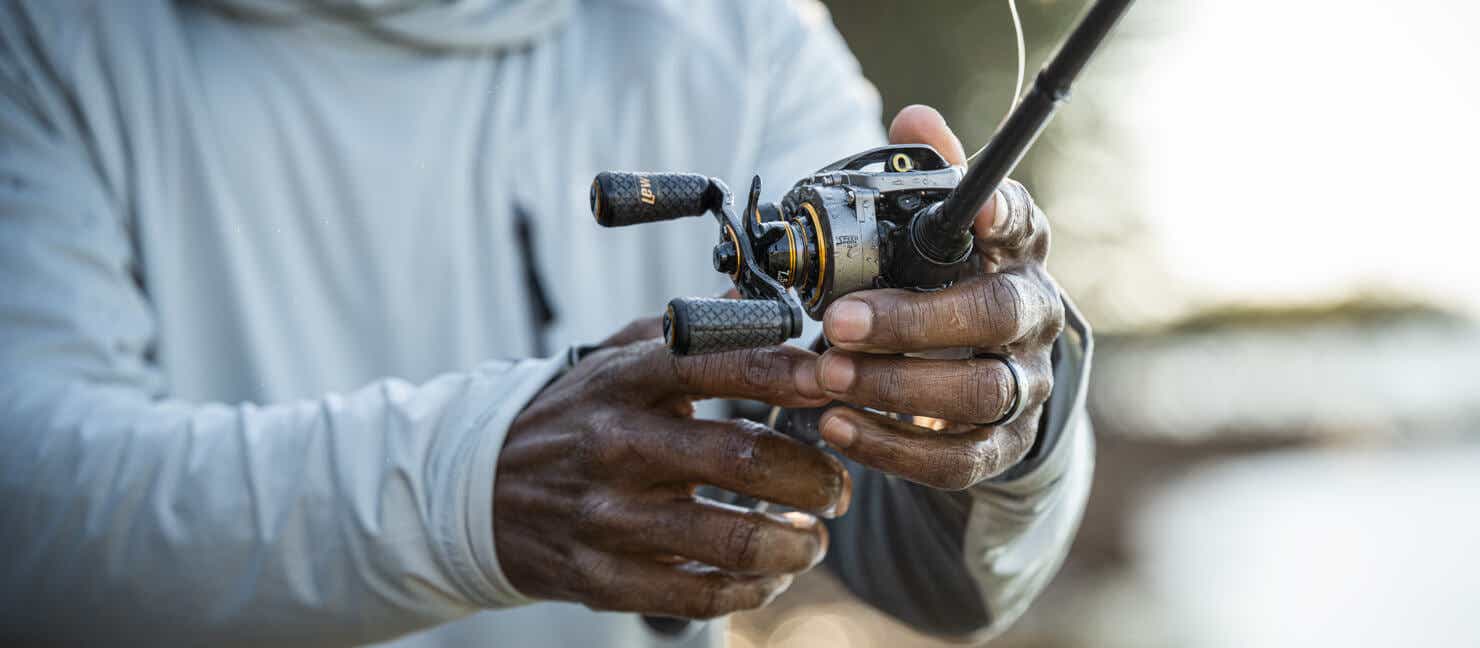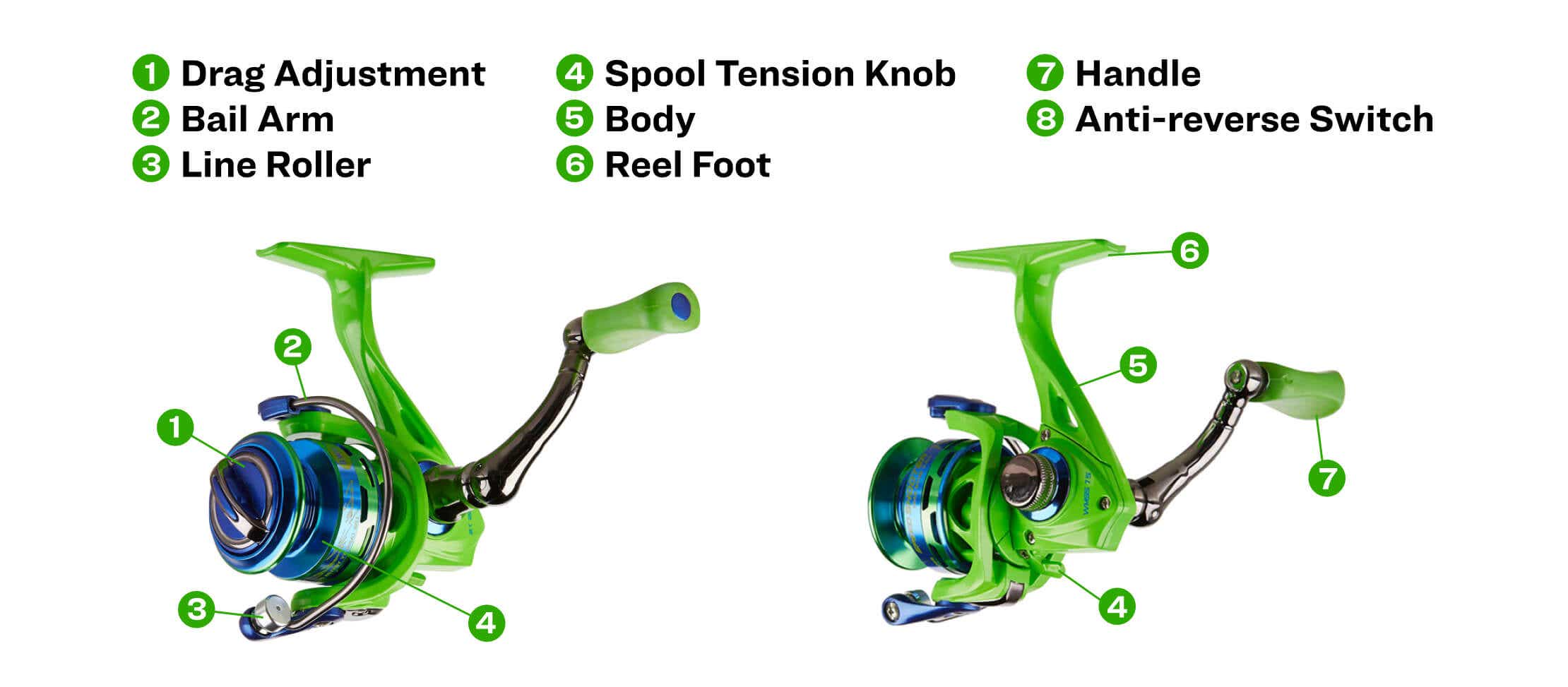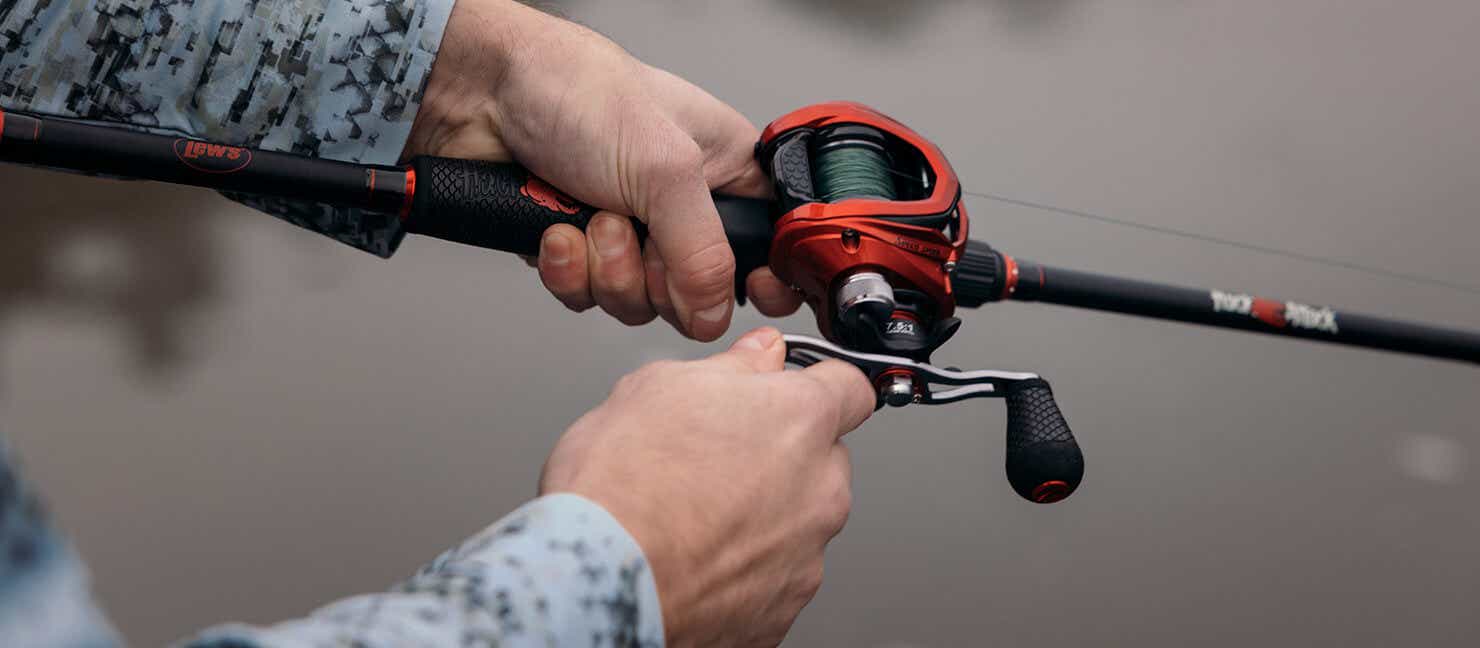Anatomy of a Fishing Reel

Baitcaster and spinning reels are two of the most popular fishing reel options on the market today. When you look at them, you'll notice the very obvious physical differences between both.
But how else do they differ? In this guide, we go beyond the more noticeable distinctions of both fishing reel types! You'll learn all about how both function, the different parts of these fishing reels, & more.
Parts of a Fishing Reel
- Drag Adjustment: The drag system applies the friction to your spool as you cast and bait a fish.
- Bait Arm: The bail controls the line on your spool.
- Line Roller: The line roller is the surface your line travels over as it’s reeled in and what makes your fishing line glide smoothly as you cast.
- Spool: The spool holds the fishing line and, along with the drag system, controls the casting distance and precision.
- Line Guide: The line guide ensures that your fishing line is spooled evenly on a baitcast reel spool.
- Spool Tension Knob: The spool tension knob on baitcast reels adjusts and fine tunes the spool rotation speed towards the end of a cast.
- Thumb Bar: On baitcasting reels, you’ll find the thumb bar (sometimes called the spool release or clutch) at the rear of the spool.
- Body (Housing): Also known as the housing, reel bodies are the main component of the reel.
- Reel Foot: The reel foot is an extension of your reel and the part that attaches your reel to your rod by a hollowing on the rod frame called a reel seat.
- Handle: The reel handle is rotated by hand to bring the fishing line back to the rod after casting.
- Anti-Reverse Switch: Anti-reverse levers prevent the reel from moving backward.
Popular Types of Fishing Reels
Two of the more popular fishing reel choices among beginner to seasoned anglers include spinning reels and baitcast reels. Each shines in different ways, but you should always understand the basic parts and their functionalities before using one. Let's explore the general anatomy of fishing reels:
Anatomy of a Spinning Reel
Spinning reels mount below a fishing rod's handle and are good all-arounder reels that are easy for beginners to use.

Anatomy of a Baitcast Reel
Experienced anglers or fishers who require heavier lures and lines for bigger game fishing use baitcast reels.

Expert Tip:
Ready to choose your next fishing reel? Learn more about the five different types of fishing reels before you commit!
Fishing Reel Parts Guide
Now that you can picture where all the parts of a fishing reel are on both a baitcast reel and spinning reel, we can dive a little deeper into the functionalities of each piece. Learn all about these components before you add another fishing rod and reel to your collection.
Drag Adjustment
Spinning reels have a dial-like knob that regulates the drag adjustment. This knob should be set according to the breaking strength of your line. Some older models may have a fixed drag system that you can't adjust. You'll find the following types of drag systems in the different types of reels:
- Lever drag system. As the name suggests, lever drag systems are set with the use of a lever near the top of the reel. This allows you to set your drag quickly and provides a handy visual indicator of the setting.
- Star drag system. Star systems are a series of washers housed within the body of the reel that provide pressure on the line, which is tightened or loosened with a simple turn of the star-shaped wheel on the outside.
Bait Arm
Open the bail to release the line from the spool, such as when casting. A closed bail prevents the spool from unwinding the line. The bail also serves as a guide for your line when winding it back onto the spool.
Line Roller
It is situated at the end of the ball-bearing wire. Too much friction in the line roller caused by rough surfaces and uneven edges is not only annoying. It can also cause your fishing line to twist, weaken, or even break.

Spool
Spools are the most common point on the reel where the line tangles. Line is secured on the spool by wrapping it around the axis. Spools have a certain line capacity. Always check the reel specifications to ensure the right fit for the type, length, and weight of the fishing line you are using.
Line Guide
Line guides help the fishing line move freely out into the water during casting and back again during the retrieve. It moves back and forth from one end of the spool to the other end as you rotate the reel handle – similar to an old typewriter’s motion.
Spool Tension Knob
Keep in mind that lures with different weights perform differently in respect to spool tension so you’ll have to re-adjust spool tension every time you rig a lure.
Thumb Bar
The thumb bar sits just below where your thumb rests on the spool for manual control. Once the thumb bar is engaged, the spool releases for casting so be sure to press it at the exact moment you want to release the line.
Body (Housing)
Your reel body should be solid with smooth operation and no loose parts. Most housing is made of graphite, aluminum, or a combination of both.
- Graphite is lighter and its corrosion-resistant qualities can better withstand saltwater fishing conditions.
- Aluminum is stronger and heavier but is also less flexible.
Expert Tip:
If you plan to spend a lot of time on the water, however, you may want to consider a lighter reel to reduce the strain on your wrist and forearm.
Reel Foot
A reel foot should fit snugly so it can withstand the constant casting and the tension when fish pull on your line. Compared to baitcasting reels, a spinning reel's foot is longer so it can properly attach to the appropriate rod.
Handle
Make sure the handle operation is smooth and comfortable in your hand as well as easily rotated with minimal effort. Round or T-shaped, the handles usually adjust to accommodate right-handed and left-handed anglers. Handles will vary in weight and length.
- Lighter handles have a quicker response time, which is a feature most bass fishers will appreciate.
- Longer handles weigh more but provide a more stable grip and may be more comfortable for anglers with larger hands.
Expert Tip:
Handles are one of the more convenient parts of a fishing reel! You can purchase them separately from the reel and are easy to replace.
Anti-Reverse Switch
Anti-reverse levers are a helpful feature, especially in bass fishing! When a fish fights and pulls out the line these levers disengage. You'll be able to reel in reverse (rather than depending on the drag system for line tension).
Spinning vs Baitcaster Reels
| Breaking Down Spinning vs Baitcaster Reels | ||||
|---|---|---|---|---|
| Category | Spinning Reels | Baitcast Reels | ||
| Mounting | Mounted underneath rod | Mounted on top of the rod | ||
| Features | Anti-reverse switch & drag system | Two-spool control mechanisms: a tension knob and a braking system | ||
| Best Used For | Great for beginners and smaller fish | Great for experienced anglers as well as bigger, trickier fish | ||
Comparing both spinning reels and baitcast reels, each reel type has different parts to know. Overall, the type of reel you choose will generally be determined by the type of fishing you plan to do. But let's compare these popular types of reels in more depth:
- In contrast to spinning reels, baitcast reels also feature more parts to allow for greater sensitivity and adjustment when casting.
- Spinning reels often come with an anti-reverse mechanism (which is helpful in preventing your line from unraveling when you get a bite).
- Baitcast reels, however, require the pressure of your thumb to keep from unspooling because they are designed to work with the weight of your bait or lure as it pulls on the line.
- Baitcast reels also usually feature a line guide and spool tension knob, which help you evenly feed your line into the spool and fine-tune your cast, respectively.

Have Fun Out There!
Whether it’s rods, reels, tackle, or traps, find everything you need to gear up for fishing—in-store and online at Academy Sports + Outdoors.


